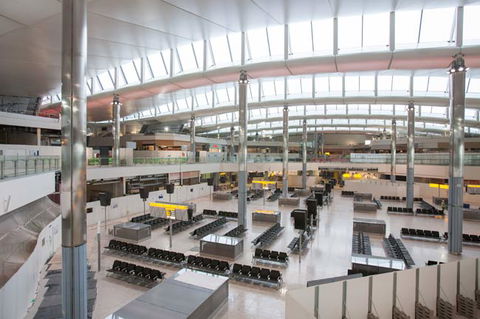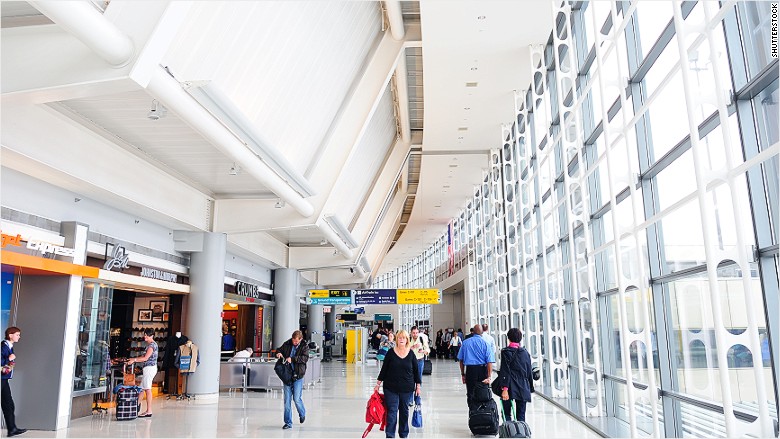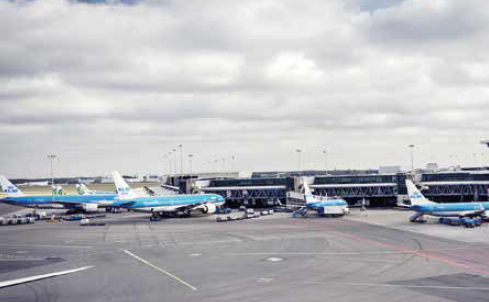If you want to see the latest in lighting technology, maybe you should take a flight…

1. PAY-AS-YOU-GO LIGHT
Instead of paying for light fittings, Schiphol Airport in Amsterdam is just paying for the light
Last year, Amsterdam’s Schiphol Airport embarked on an ambitious renovation of one of its main departure lounges, including custom-designed LED lighting. But it’s not just the lights that’s unique, it’s the way they’re being supplied.
Schiphol won’t be paying for its new lighting system – it will just pay for the light it emits.
The airport has opted for ‘light as a service’ through a deal with Philips and energy services company Cofely. Philips leases the fittings to the airport, which pays for the light it uses. Cofely, which has a 24-hour presence at the airport, maintains the lighting on the basis of agreed performance indicators.
The deal overcomes the upfront cost barrier to going LED, and the airport – Europe’s fourth busiest – expects to cut its lighting energy bill in half.
Philips worked with architect Kossmann. dejong to develop custom fittings that are expected to last 75 per cent longer than conventional ones because they are easier to service, and components can be replaced.
This isn’t Philips’ first foray into pay-as-you-go lighting. The Washington Metro in the US signed a similar 10-year contract in November last year, and in 2013 the UK’s National Union of Students installed a pay-as-you-go lighting scheme at its London headquarters.
Philips hopes that more companies will now embrace these kinds of business models. As Frank van der Vloed, Philips Lighting’s general manager for the Benelux region, puts it: ‘I drink water but I don’t have a reservoir in my basement.’
2. LIGHTS THAT WORK TOGETHER WITH DAYLIGHT
The artificial lighting at China’s Shenzhen Airport blends with daylight
The new, mile-long terminal at China’s Shenzhen Airport has been built to cope with growing demand for air travel to and from the city. It operates constantly, so its lighting design had to balance natural and artificial illumination over a 24-hour cycle. The building is wrapped in an undulating double-skin roof punctuated by thousands of hexagonal skylights. Daylight streams in, creating a moving play of light and shadow inside.
The lighting system is designed to echo the play of daylight and smooth the transition from day into night, using fittings concealed in the roof void.
As well as serving as a home for the light fittings, the void between the roof’s two skins is internally lit to create a ‘paper lantern’ effect that both lifts and frames the space at night.
Light levels are gradually lowered near to windows and glass walls, to preserve views of the outside.
3. LIGHTS THAT MONITOR TRAFFIC
The lighting in Newark Airport’s car park already tracks your movements, and might soon be able to order your coffee
The car park lighting at Newark Airport in New Jersey is the smartest in the world. It monitors traffic, provides updates on the availability of parking spaces and even tracks suspicious activity, such as people stopping at a number of different cars.
In future it might be able to underpin more sophisticated services – like recognising travellers when they arrive and having their coffee order ready when they arrive at the Starbucks in the terminal.
Developed by Sensity Systems, the lighting is part of a wireless data collection network. The system currently consists of 174 retrofitted LED fittings connected to various sensors and cameras installed around the parking area of the airport terminal.
Each luminaire has a networking module with Wi-Fi, and sensors to monitor temperature, motion, ambient light and power. A few of the fittings also have cameras, and two of them can recognise licence plates.
4. LIGHTS THAT CHANGE COLOUR
Colour-changing lighting at Muscat Airport in Oman will be seen by passengers on the ground and in the air
Muscat Airport is the largest development project undertaken in Oman. Air travel to the city has outgrown the existing airport, designed back in 1973, so a new airport has been designed. The new terminal, under construction now, will handle 12 million passengers a year, with further expansion plans in the pipeline.
UK manufacturer ACDC won a £5 million ($8 million) contract to supply the airpot with 8,000 LED downlights, several thousand RGB floods, and over 31,000 metres of linear LED products that will change the colour of the glass ceiling panels in the terminal building, visible from the air as planes come in to land.
ACDC is working with lighting designer LDPI on lighting for the exterior façade and landscape of the newly built airport’s surrounding site and vehicular approaches, and interior public areas.
The airport will be using ACDC’s Integrex linear LED wallwash luminaire, and its Fino linear LED luminaire, which is rated IP68, to provide even, continuous and powerful light output.
5. DIFFUSE DAYLIGHT
Heathrow Airport’s new terminal uses a special material to diffuse daylight
The brand new £2.5 billion Terminal 2 at London’s Heathrow Airport features a bold, undulating roof.
The design team wanted to use as much daylight as possible, but at the same time wanted to avoid strong contrasts from direct sunlight, which can make areas in shadow seem very dark.
The roof is designed with north-facing windows, so that daylight gets in, but direct sunlight is minimised. Lighting designers from Hoare Lea worked with architects Foster + Partners and Luis Vidal to develop a material that could be stretched over the soffit and diffuse the light as it came in.
Luminaires were also incorporated into the soffits so that the same effect could be achieved at nighttime, and in areas where daylight doesn’t reach.
Jonathan Rush of Hoare Lea said: ‘The concept was that the soffit would be a continued element with unobstructed views as much as possible. The patterns of daylight would be mimicked with artificial light. We internally illuminated this soffit material we developed to create this internal brightness that would mimic that of the daylight impression.’
The material had to be perforated to achieve the right acoustics, so the team added a secondary diffuser underneath the luminaire, to prevent bright spots being visible. ‘This quality of detailing was really vital,’ said Rush.
By carefully considering the perceived levels of brightness – which are affected by contrast levels as well as by the amount of light – the team managed to create the right effect and keep energy use low – the lighting has an electrical load of just 7W/m2 at night, falling to 4.5W/m2 during the day.


